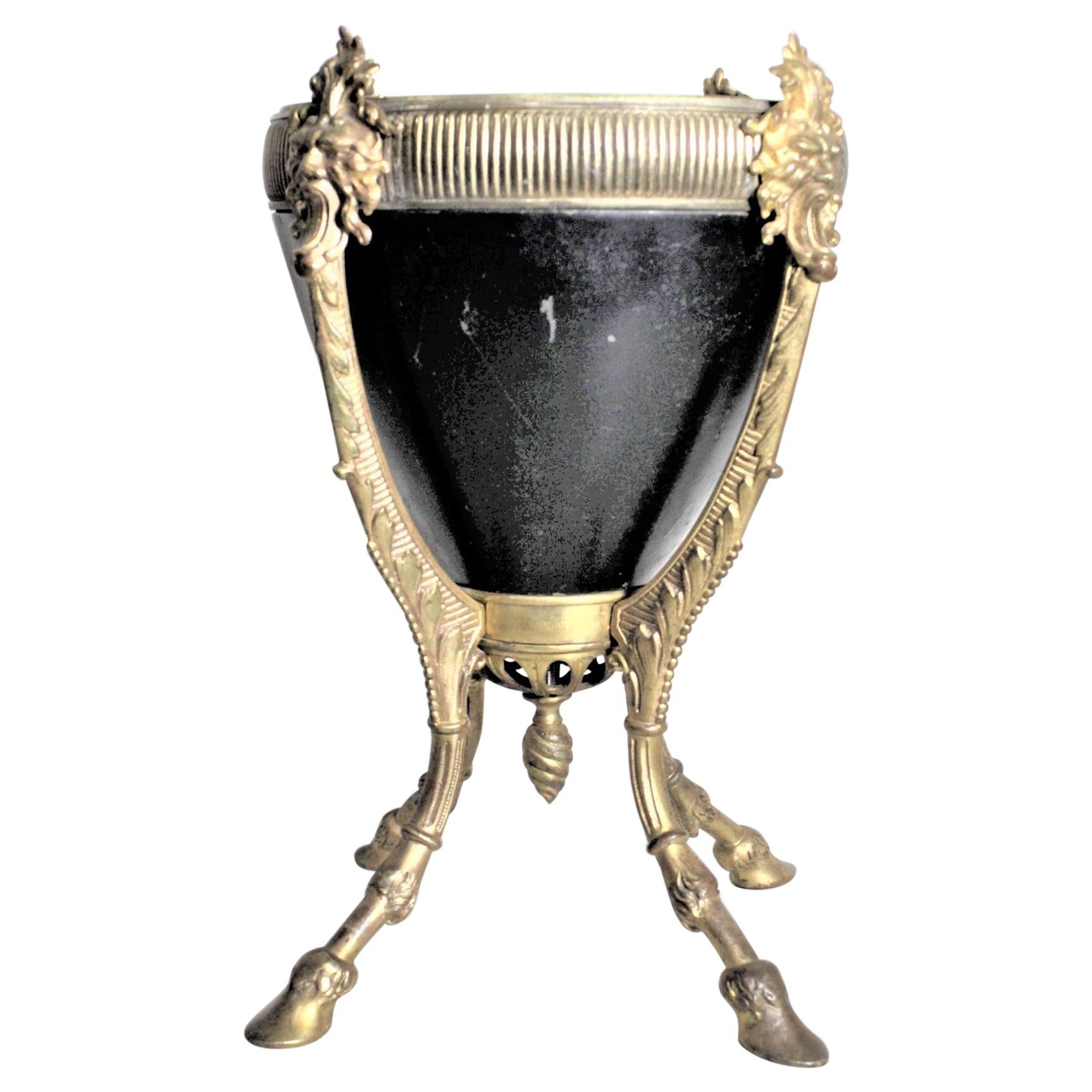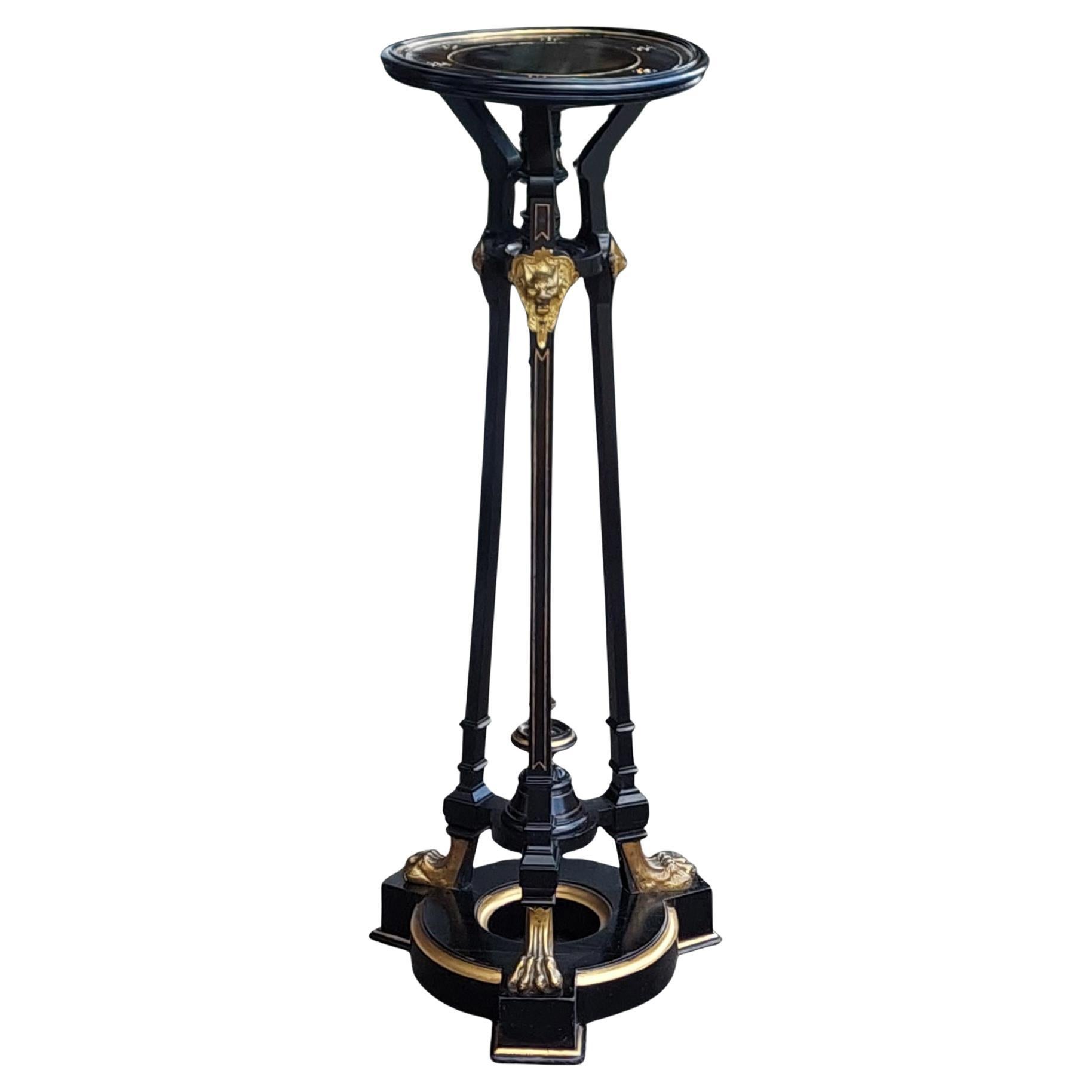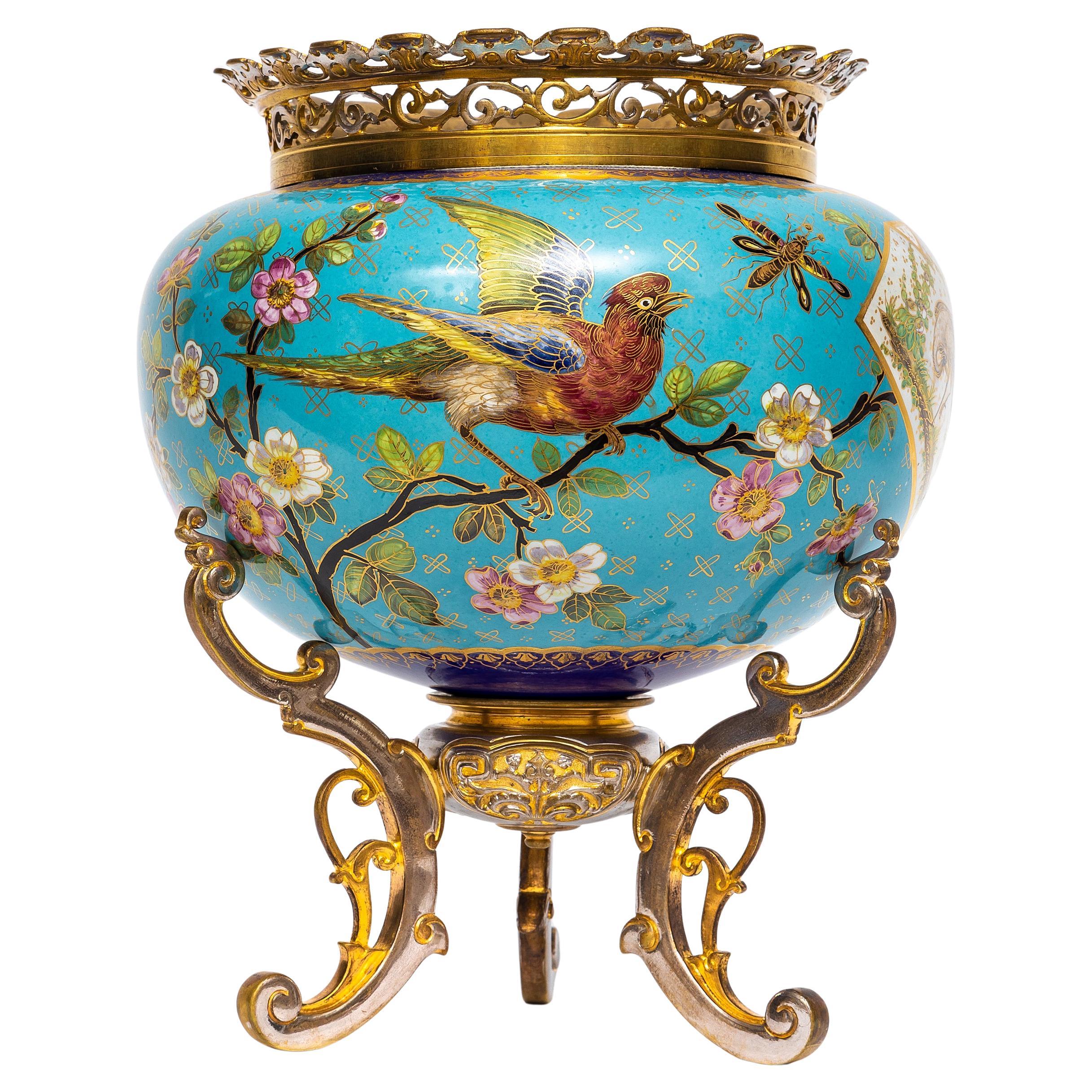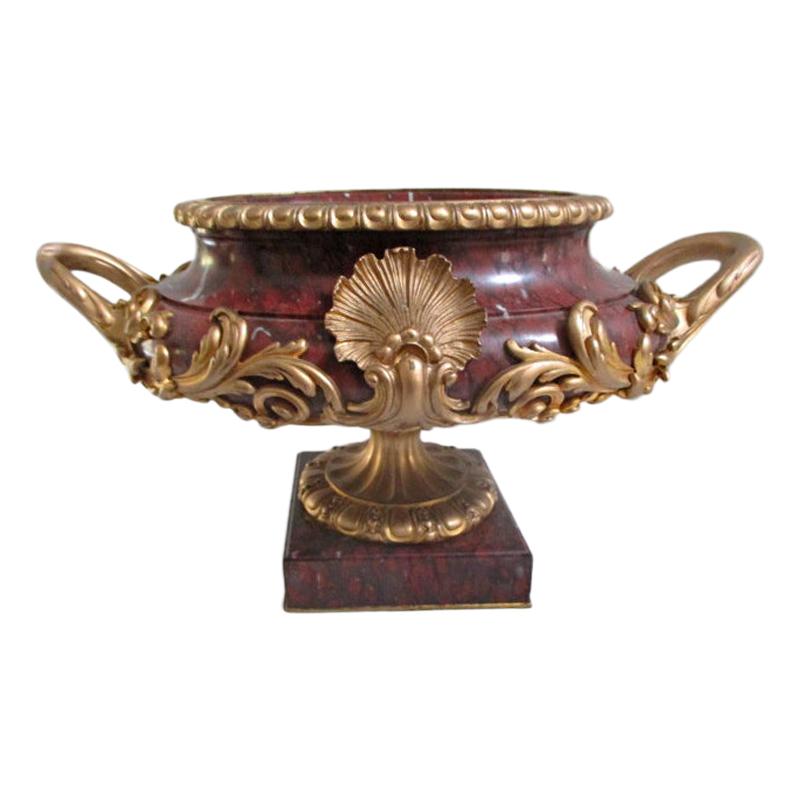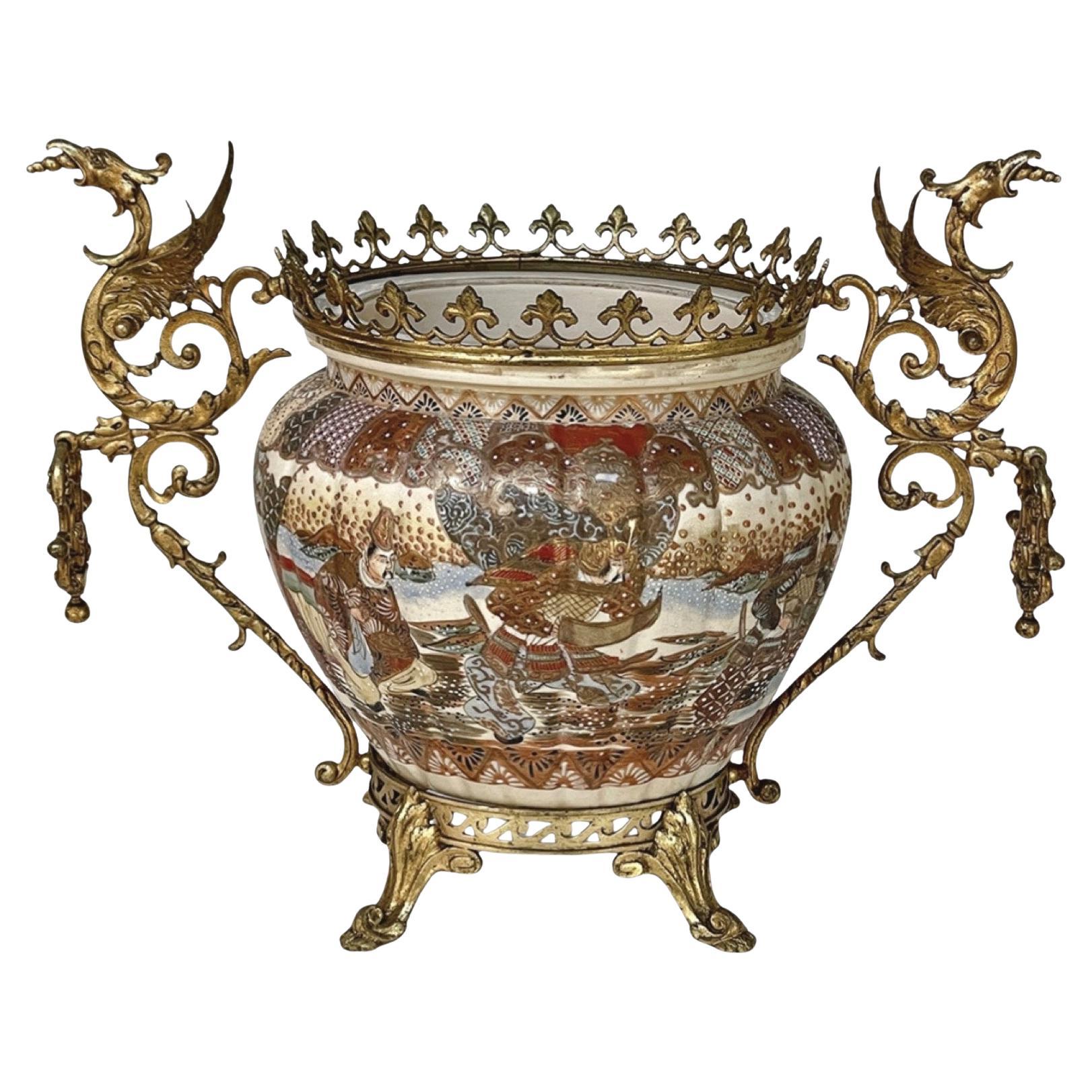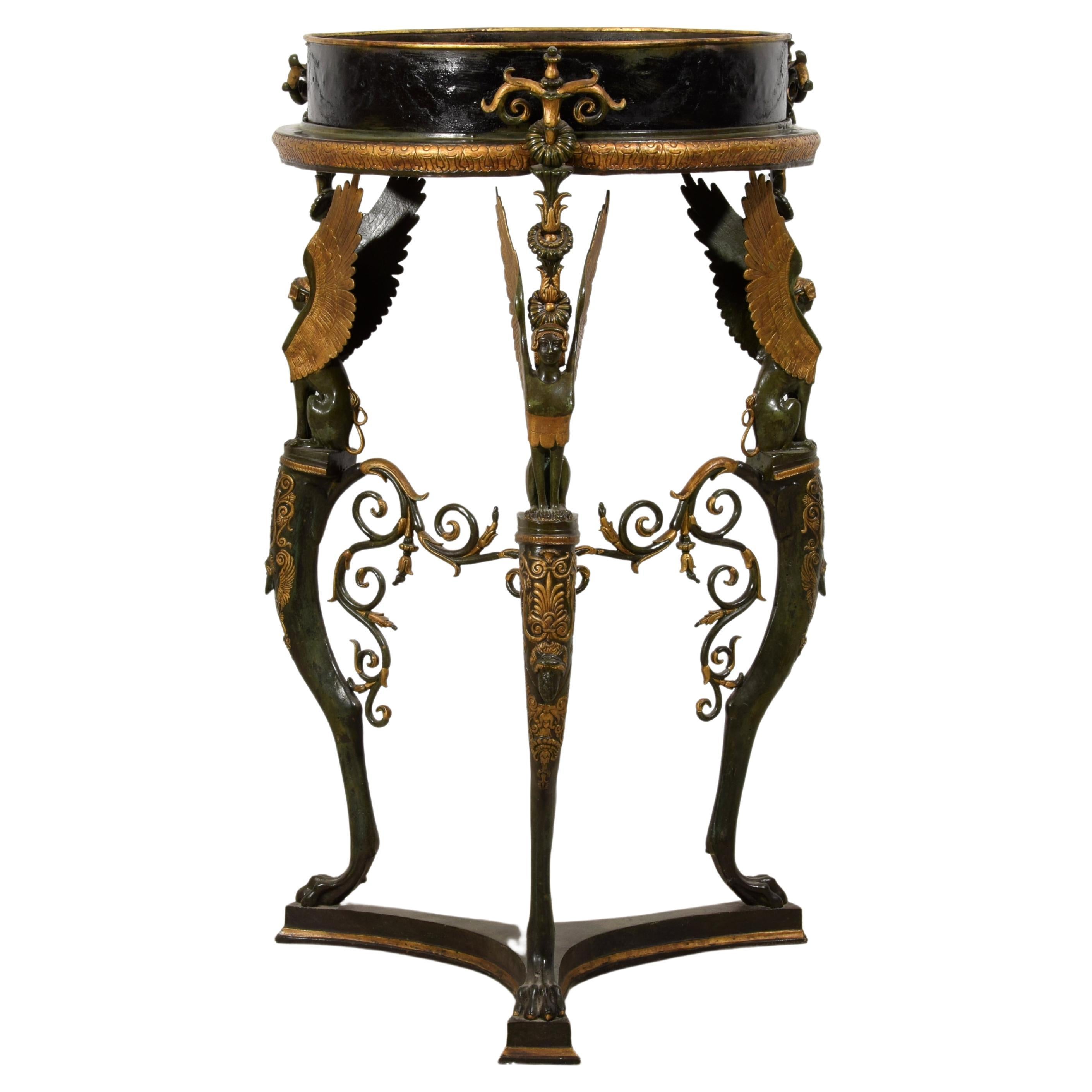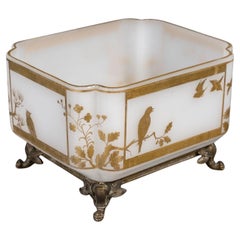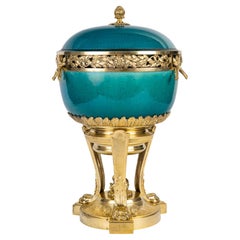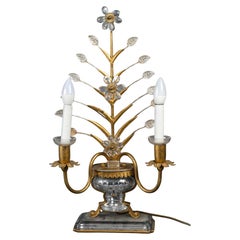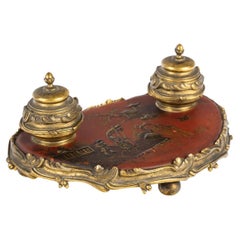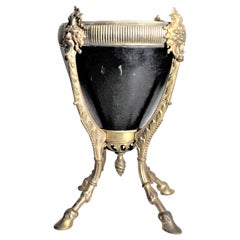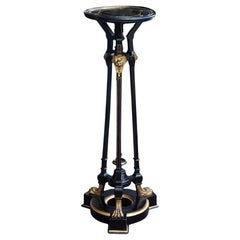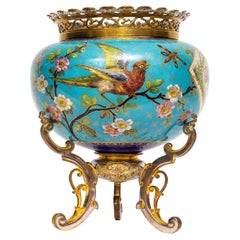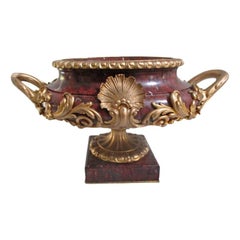Items Similar to French Japonisme Lacquered Metal Jardinière on Ormolu Stand Signed Marnyhac
Want more images or videos?
Request additional images or videos from the seller
1 of 11
French Japonisme Lacquered Metal Jardinière on Ormolu Stand Signed Marnyhac
$17,829.40
£13,277.34
€15,000
CA$24,615.90
A$27,290.36
CHF 14,342.15
MX$333,989.29
NOK 179,118.88
SEK 168,120.99
DKK 114,205
About the Item
Jardinière Médicis vase shape in copper with gold lacquered decoration on a burgundy background of a Japanese landscape with a volcano and an eagle in the foreground.
Gilt bronze handles in the shape of winged dragons.
Gilded bronze bamboo tripod base.
After a design by Edouard Lièvre (1829-1886) for Maison Marnyhac, Paris.
Signed "Marnyhac 1, rue de la Paix.",
circa 1870
Maison Marnyhac was the commercial name for la Société des Marbres et Bronzes Artistiques de Paris and was established under the direction of Charles de Marnyhac in Paris in the mid-19th century. They specialized in the creation of luxury items, engaging the best designers to work in their premises, Marnyhac Paris exhibited at The Exposition Universelle in 1878 where they obtains a medal.
The present stand was designed by Edouard Lièvre (1829-1886) who was accredited with creating a combination Sino-Japanese style of design at the end of the 19th century as the Aesthetic Movement was.
Born in 1828 in a modest family, Edouard Lièvre followed the traditional program of painting formation before to direct to the ornamental drawing. If he used to work for the Maison Marnyhac, he also drew for Christofle, Barbedienne or the Escalier De crystal, his creations were very studied by his contemporaries as Sarah Bernhardt or Edouard Detaille.
The second half of the 19th century is characterized by the eclecticism of sources of inspiration; Far East indeed knows a renewed interest with the opening of Japan on the western world from 1868. The fashion for the "Japanese curiosa" and the "chinoiserie" is reflected in the contemporary creations, integrating a vocabulary expert on Japan or becoming Sinicized in their decoration which corresponds perfectly to the taste of the period.
We find here, the exceptional quality of execution but also the ornamental directory expert on Japan with motive for fancies, bamboo and usual valances to this draughtsman, among the most prolix and the most talented of his time.
- Creator:Maison Marnyhac 1 (Manufacturer)
- Attributed to:Edouard Lievre (Designer)
- Dimensions:Height: 47.25 in (120 cm)Diameter: 21.26 in (54 cm)
- Style:Japonisme (Of the Period)
- Materials and Techniques:
- Place of Origin:
- Period:
- Date of Manufacture:circa 1870
- Condition:Wear consistent with age and use.
- Seller Location:Saint-Ouen, FR
- Reference Number:1stDibs: LU2612323487052
About the Seller
4.8
Vetted Professional Seller
Every seller passes strict standards for authenticity and reliability
1stDibs seller since 2017
68 sales on 1stDibs
Typical response time: <1 hour
- ShippingRetrieving quote...Shipping from: Saint-Ouen, France
- Return Policy
Authenticity Guarantee
In the unlikely event there’s an issue with an item’s authenticity, contact us within 1 year for a full refund. DetailsMoney-Back Guarantee
If your item is not as described, is damaged in transit, or does not arrive, contact us within 7 days for a full refund. Details24-Hour Cancellation
You have a 24-hour grace period in which to reconsider your purchase, with no questions asked.Vetted Professional Sellers
Our world-class sellers must adhere to strict standards for service and quality, maintaining the integrity of our listings.Price-Match Guarantee
If you find that a seller listed the same item for a lower price elsewhere, we’ll match it.Trusted Global Delivery
Our best-in-class carrier network provides specialized shipping options worldwide, including custom delivery.More From This Seller
View AllJaponisme Ormolu-Mounted Opaline Jardiniere by Maison Baccarat, circa 1865
By Baccarat
Located in Saint-Ouen, FR
Japonisme Ormolu-Mounted Opaline Jardiniere by Maison Baccarat, circa 1865
A French Japonisme rectangular shape with double lobed corners Jardiniere
White Opaline glass with gold han...
Category
Antique 1860s French Japonisme Planters, Cachepots and Jardinières
Materials
Ormolu
A French 19th Century Pot-Pourri Covered Vase
Located in Saint-Ouen, FR
A French 19th Century Pot-Pourri Covered Vase
Large pot-pourri covered and ormolu-mounted ceramic vase
Resting on an ormolu base simulating a perfume burner with posts in claws.
L...
Category
Antique 1860s French Louis XVI Vases
Materials
Ormolu
$3,565 Sale Price
33% Off
Maison Baguès, “Urn with Flowers”Lamp circa 1950
By Maison Baguès
Located in Saint-Ouen, FR
Maison Baguès,
“Urn with Flowers”Lamp circa 1950
French Glass & Gilt Metal «Vase of Flowers» two-lights Table Lamp
Designed as a both faces crystal vase which crystal leaves and flowers on a gilt-metal stem
Since the 1860s, the renowned French luxury lighting atelier Maison Baguès has been pro-ducing pieces that are highly valued across the world. Each piece is hand assembled, using traditional techniques.
Depending on the source you consult, French luxury lighting atelier Maison Baguès was launched in Paris in 1860, or in Auvergne in 1840. Still active today, the brand remains an exemplar of French design savoir-faire.
Under founding metalsmith Nöel Baguès’s direction, Maison Baguès began as a specialist in liturgical bronze candlesticks, before late-19th-century technological advancement—and the 1880 managerial arrival of Nöel’s son, Eugène—saw the broadening of the atelier’s range to include bronze fixtures for newly-invented electrical lighting. Expansion drove the following decades, as Eugène, together with his own sons, Victor and Robert, continued to swell out the atelier’s Art Deco-tinged output. By the 1920’s, Maison Baguès’s collections included gilded iron fixtures—the iconic Parrots & Foliage hand-strung crystal chandeliers and complexly carved wall sconces —as well as metal gates, accent tables, and stair bannis-ters (which still adorn Parisian locales like the Porte Dorée and the Théâtre des Champs-Elysées).
Delicate and detailed, Maison Baguès’s bespoke designs and metalwork attracted the social elite. In 1928, eminent bourgeoisie décorateur Armand-Albert Rateau famously used a se-lection of Maison Baguès accessories to furnish the townhouse interiors of haute couturist Jeanne Lanvin. Beyond Rateau, the atelier was commissioned by many chic interiors icons...
Category
Vintage 1950s French Art Deco Table Lamps
Materials
Brass
$2,674 Sale Price
50% Off
An Ormolu and Coromandel Lacquer Inkwell, circa 1880
By L'Escalier de Cristal
Located in Saint-Ouen, FR
An Ormolu and Coromandel Lacquer Inkwell, circa 1880
Chiseled and gilded bronze inkwell composed of a chantered shape tray in Coromandel lacquer, moulded edge in chiselled and gilded...
Category
Antique 1870s French Chinoiserie Inkwells
Materials
Ormolu
19th Century French Japonisme Inkwell attributed to L'Escalier de Cristal
By L'Escalier de Cristal
Located in Saint-Ouen, FR
A very nice quality French Japonisme Style inkwell
Attributed to l'Escalier de Cristal, circa 1880
Resting on a diamond-shaped polychromed hand-painted porcelain tray representing l...
Category
Antique Late 19th Century French Japonisme Inkwells
Materials
Ormolu
Théodore Deck (1823-1891), A 19th French Japonisme Cache-Pot, circa 1875
By Theodore Deck
Located in Saint-Ouen, FR
Théodore Deck (1823-1891)
A 19th French Japonisme Cache-Pot, circa 1875
A Polychrome Enameled Faience Round-Shaped Cachepot and Jardinière
Hand-painted design in the Japonisme Aesth...
Category
Antique 1870s French Japonisme Planters, Cachepots and Jardinières
Materials
Faience
You May Also Like
Antique French Jardinière or Planter with Gilt Bronze Figural Mounts
Located in Hamilton, Ontario
This antique gilt bronze and cast iron jardinière is unsigned, but presumed to have been made in France in approximately 1900 This planter is done with a conical shaped cast iron pot...
Category
Early 20th Century French Louis XVI Planters, Cachepots and Jardinières
Materials
Bronze, Iron
Late19thC Ebonized & Ormolu Mounted Jardiniere Stand
Located in Altrincham, GB
Late19thC Ebonised & Ormolu Mounted Jardiniere Stand - of tapered Aesthetic form with lion paw feet and circular top - 15" diam (13" at the top) x 37.5"h
Category
Antique 1860s English Aesthetic Movement Planters, Cachepots and Jardini...
Materials
Ormolu
19th C. Japanisme French Porcelain Jardinière w/ Gilt and Silvered-Bronze Stand
By Edouard Lievre
Located in New York, NY
An Antique 19th Century Japanism French Porcelain Jardinière with Gilt and Silvered-Bronze Tri-Footed Stand. This jardinière is in the Jap...
Category
Antique 1880s French Japonisme Planters, Cachepots and Jardinières
Materials
Bronze
19th Century Gilt Bronze-Mounted Rouge Griotte Marble Jardinière
Located in New York, NY
A fine quality Ormolu-mounted and gilt bronze rouge Griotte marble Jardinière centerpiece attributed to Ferdinand Barbedienne.
Gadrooned gilt bronze mounted with elaborate foliate s...
Category
Antique 19th Century French Planters, Cachepots and Jardinières
Materials
Griotte Marble, Bronze
19th Century Bronze Mounted Satsuma Jardiniere
Located in Dallas, TX
19th Century bronze mounted satsuma jardiniere is a splendidly preserved artifact from a wonderful period in French history! The porcelain bowls wer...
Category
Antique 1880s French Meiji Planters, Cachepots and Jardinières
Materials
Bronze
20th Century, Italian Bronze Planter or Gueridon
Located in IT
20th century, Italian bronze planter or Gueridon
Measures: cm W 56 x maximum diameter 51 x H 90. H on the floor of the wide 81 cm
This refined planter was made in Italy, in Naples, towards the Early 20th Century in the style of «Retour d'Egypte».
It consists of a tripod structure in finely chiselled gilded bronze and lacquered in tones. Each leg originates with scroll decorations and phytomorphic elements with golden details, supported by a sphinx with hairstyle, tail and golden wings. This sits on a curvilinear and wavy element decorated with golden ramage and a man’s head with a long beard of classic taste. The legs end with an injured foot and rest on a tripartite base that connects them. In the middle of each leg there is a bronze junction with curls and volutes that converges towards the others in the center, where a vertical element contributes to the momentum and gracefulness of the whole.
The basin of the planter is in lacquered tin, with gold edges and reserves. The rising part of the tub has some holes that allow the breathability of the space.
This tripod is inspired, with variations, to a famous model of the brothers Luigi and Antonio Manfredini, active in Milan at the beginning of the nineteenth century, financed by the viceroy of Italy Eugenio de Beauharnais, adopted son of Napoleon Bonaparte, for the opening of the real manufacture of Eugenia.
The Retour d'Egypte style was widely echoed in France and Europe and originated from General Bonaparte’s military campaign in Egypt in 1799. The fashion of the Egyptians had already in Italy found a previous interpreter in the engraver Giovan Battista Piranesi, but the vast diffusion that also had in the furniture the Egyptian ornament...
Category
Early 20th Century Italian Louis XVI Gueridon
Materials
Metal, Bronze
More Ways To Browse
Antique Metal Shaper
Antique Western Signs
French Japonisme
Vessel With Metal Stand
19th Century Chinoiserie Vase
Gold Gilt Planter
Crystal Vases With Handles
Gilt Bronze Jardiniere
Tripod Vase
Paris Jardiniere
Medici Vase
Signed Bronze Vase Japanese
Chinoiserie Vase Gold
Winged Dragon
Bronze Dragon Vase
19th Century Lacquer Vases
Crystal Gilt Bronze Vase
Chinoiserie French Vases
